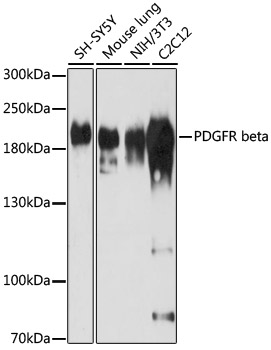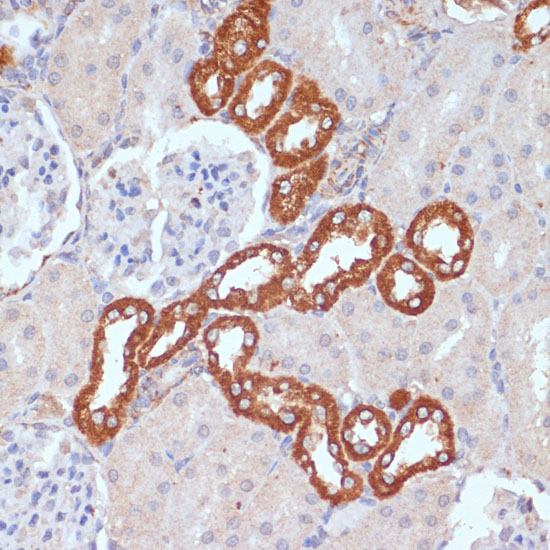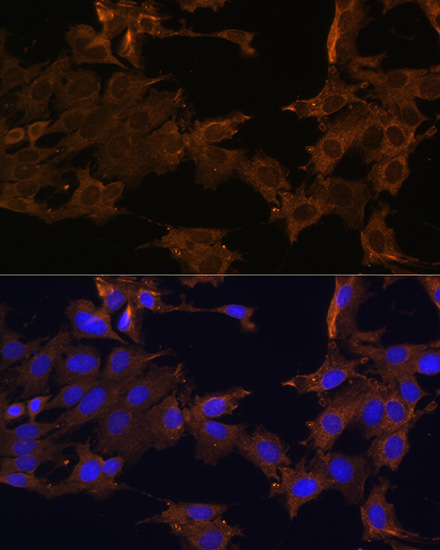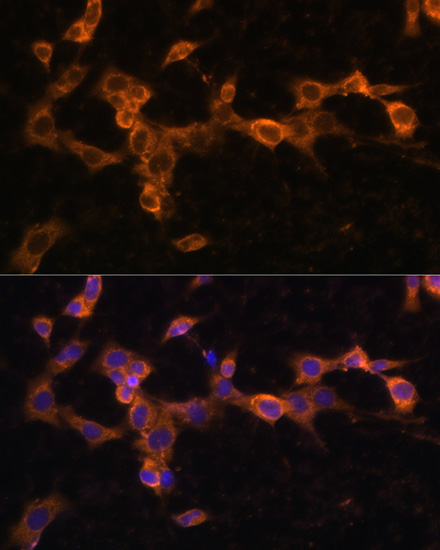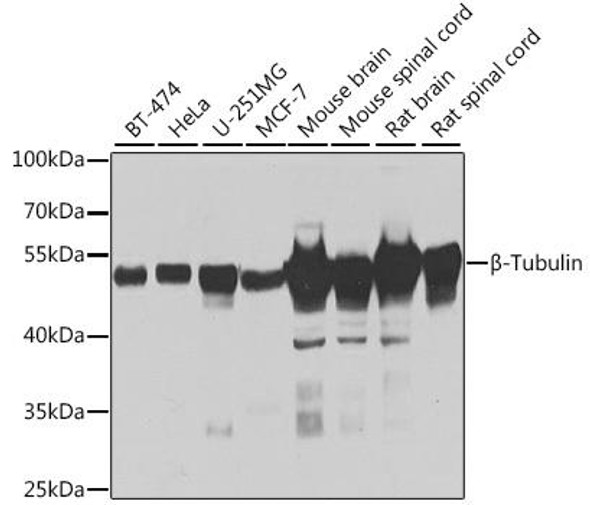Cell Biology Antibodies 8
Anti-PDGFR beta Antibody (CAB2180)
- SKU:
- CAB2180
- Product Type:
- Antibody
- Reactivity:
- Human
- Reactivity:
- Mouse
- Reactivity:
- Rat
- Host Species:
- Rabbit
- Isotype:
- IgG
- Research Area:
- Cell Biology
Description
| Antibody Name: | Anti-PDGFR beta Antibody |
| Antibody SKU: | CAB2180 |
| Antibody Size: | 20uL, 50uL, 100uL |
| Application: | WB IHC IF |
| Reactivity: | Human, Mouse, Rat |
| Host Species: | Rabbit |
| Immunogen: | Recombinant fusion protein containing a sequence corresponding to amino acids 887-1106 of human PDGFR beta (NP_002600.1). |
| Application: | WB IHC IF |
| Recommended Dilution: | WB 1:500 - 1:2000 IHC 1:50 - 1:200 IF 1:50 - 1:200 |
| Reactivity: | Human, Mouse, Rat |
| Positive Samples: | SH-SY5Y, mouse lung, NIH/3T3, C2C12 |
| Immunogen: | Recombinant fusion protein containing a sequence corresponding to amino acids 887-1106 of human PDGFR beta (NP_002600.1). |
| Purification Method: | Affinity purification |
| Storage Buffer: | Store at -20'C. Avoid freeze / thaw cycles. Buffer: PBS with 0.02% sodium azide, 50% glycerol, pH7.3. |
| Isotype: | IgG |
| Sequence: | WSFG ILLW EIFT LGGT PYPE LPMN EQFY NAIK RGYR MAQP AHAS DEIY EIMQ KCWE EKFE IRPP FSQL VLLL ERLL GEGY KKKY QQVD EEFL RSDH PAIL RSQA RLPG FHGL RSPL DTSS VLYT AVQP NEGD NDYI IPLP DPKP EVAD EGPL EGSP SLAS STLN EVNT SSTI SCDS PLEP QDEP EPEP QLEL QVEP EPEL EQLP DSGC PAPR AEAE DSFL |
| Gene ID: | 5159 |
| Uniprot: | P09619 |
| Cellular Location: | Cell membrane, Cytoplasmic vesicle, Lysosome lumen, Single-pass type I membrane protein |
| Calculated MW: | 37kDa/123kDa |
| Observed MW: | 200kDa |
| Synonyms: | CD140B, IBGC4, IMF1, JTK12, KOGS, PDGFR, PDGFR-1, PDGFR1, PENTT, PDGF Receptor beta, PDGFRB, PDGFR beta |
| Background: | This gene encodes a cell surface tyrosine kinase receptor for members of the platelet-derived growth factor family. These growth factors are mitogens for cells of mesenchymal origin. The identity of the growth factor bound to a receptor monomer determines whether the functional receptor is a homodimer or a heterodimer, composed of both platelet-derived growth factor receptor alpha and beta polypeptides. This gene is flanked on chromosome 5 by the genes for granulocyte-macrophage colony-stimulating factor and macrophage-colony stimulating factor receptor; all three genes may be implicated in the 5-q syndrome. A translocation between chromosomes 5 and 12, that fuses this gene to that of the translocation, ETV6, leukemia gene, results in chronic myeloproliferative disorder with eosinophilia. |
| UniProt Protein Function: | PDGFRB: a receptor tyrosine kinase of the PDGFR family that binds members of the platelet-derived growth factor family. The identity of the growth factor bound determines whether the functional receptor is a homodimer or a heterodimer, composed of both PDGFR-alpha and -beta. Ligand binding induces receptor dimerization and autophosphorylation, thereby recruiting SH2-containing proteins including Grb2, Src, GAP, PTPN11, PI3 kinase, PLC-gamma and Nck. Regulates cell growth, actin reorganization, migration and differentiation. A variety of myeloproliferative disorders and cancers result from translocations that activate PDGFRbeta by fusion with proteins such as TEL/ETV6, H2, CEV14/TRP11, rabaptin 5, and huntington interacting protein 1. Gleevec treatment of TEL fusions has been successful. Overexpressed in metastatic medulloblastoma. Inhibitors: Gleevec, Sutent. |
| UniProt Protein Details: | Protein type:EC 2.7.10.1; Kinase, protein; Membrane protein, integral; Oncoprotein; PDGFR family; Protein kinase, TK; Protein kinase, tyrosine (receptor); TK group Chromosomal Location of Human Ortholog: 5q32 Cellular Component: apical plasma membrane; cytoplasm; focal adhesion; intrinsic to plasma membrane; membrane; nucleus; plasma membrane Molecular Function:enzyme binding; phosphatidylinositol-4,5-bisphosphate 3-kinase activity; platelet activating factor receptor activity; platelet-derived growth factor beta-receptor activity; platelet-derived growth factor binding; platelet-derived growth factor receptor activity; platelet-derived growth factor receptor binding; protein binding; protein kinase binding; protein-tyrosine kinase activity; Ras guanyl-nucleotide exchange factor activity; receptor binding Biological Process: cardiac myofibril assembly; cell migration; MAPKKK cascade; peptidyl-tyrosine phosphorylation; phosphatidylinositol metabolic process; phosphoinositide-mediated signaling; platelet-derived growth factor receptor signaling pathway; positive regulation of cell migration; positive regulation of cell proliferation; positive regulation of chemotaxis; positive regulation of MAP kinase activity; positive regulation of mitosis; positive regulation of phosphoinositide 3-kinase activity; positive regulation of phosphoinositide 3-kinase cascade; positive regulation of phosphoprotein phosphatase activity; positive regulation of smooth muscle cell migration; positive regulation of smooth muscle cell proliferation; protein amino acid autophosphorylation; regulation of actin cytoskeleton organization and biogenesis; regulation of phosphoinositide 3-kinase cascade; signal transduction Disease: Basal Ganglia Calcification, Idiopathic, 1; Basal Ganglia Calcification, Idiopathic, 4; Kosaki Overgrowth Syndrome; Myeloproliferative Disorder, Chronic, With Eosinophilia; Myofibromatosis, Infantile, 1; Premature Aging Syndrome, Penttinen Type |
| NCBI Summary: | This gene encodes a cell surface tyrosine kinase receptor for members of the platelet-derived growth factor family. These growth factors are mitogens for cells of mesenchymal origin. The identity of the growth factor bound to a receptor monomer determines whether the functional receptor is a homodimer or a heterodimer, composed of both platelet-derived growth factor receptor alpha and beta polypeptides. This gene is flanked on chromosome 5 by the genes for granulocyte-macrophage colony-stimulating factor and macrophage-colony stimulating factor receptor; all three genes may be implicated in the 5-q syndrome. A translocation between chromosomes 5 and 12, that fuses this gene to that of the translocation, ETV6, leukemia gene, results in chronic myeloproliferative disorder with eosinophilia. [provided by RefSeq, Jul 2008] |
| UniProt Code: | P09619 |
| NCBI GenInfo Identifier: | 129890 |
| NCBI Gene ID: | 5159 |
| NCBI Accession: | P09619.1 |
| UniProt Secondary Accession: | P09619,Q8N5L4, B5A957, |
| UniProt Related Accession: | P09619 |
| Molecular Weight: | Calculated: 37kDa/123kDaObserved: 170kDa |
| NCBI Full Name: | Platelet-derived growth factor receptor beta |
| NCBI Synonym Full Names: | platelet derived growth factor receptor beta |
| NCBI Official Symbol: | PDGFRB |
| NCBI Official Synonym Symbols: | IMF1; KOGS; IBGC4; JTK12; PDGFR; PENTT; CD140B; PDGFR1; PDGFR-1 |
| NCBI Protein Information: | platelet-derived growth factor receptor beta |
| UniProt Protein Name: | Platelet-derived growth factor receptor beta |
| UniProt Synonym Protein Names: | Beta platelet-derived growth factor receptor; Beta-type platelet-derived growth factor receptor; CD140 antigen-like family member B; Platelet-derived growth factor receptor 1; PDGFR-1; CD_antigen: CD140b |
| Protein Family: | Platelet-derived growth factor receptor |
| UniProt Gene Name: | PDGFRB |


